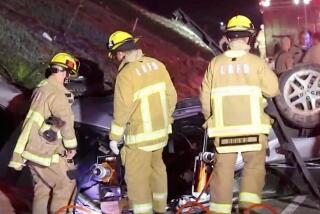Crane Topples on Ventura Freeway : Traffic: The eastbound lanes are tied up for several hours after the early morning accident. No motorists are injured.
A construction crane fell over on the Ventura Freeway early Wednesday, dumping a boom arm and a five-ton slab of concrete onto a transition road below and turning the already sluggish freeway into a virtual parking lot.
The transition road, connecting the eastbound Ventura Freeway to the southbound San Diego Freeway, was closed at the time for work on the Ventura Freeway improvement project. Although some traffic lanes on the Ventura were open to the right of the crane, it fell to the left, away from traffic.
Crane operator David Loyd suffered minor cuts and bruises when the device toppled as it moved the concrete barrier into place at the interchange with the San Diego Freeway about 4:50 a.m. No one else was injured.
It was the first major mishap on the freeway improvement project, Caltrans officials said.
They said crews were installing new guard rails on the freeway interchange--work that required the closure of one eastbound lane and several transition roads between midnight and 5 a.m.
At the time of the accident, the crane was replacing 20-foot temporary concrete barriers. Crews already had replaced 15 to 20 of the barriers and were scheduled to reopen the closed freeway lanes and transition roads as soon as the final barrier was in place, said Jim McAllister, Caltrans resident engineer for the improvement project.
But the crane, which was in a closed traffic lane, tipped and rolled onto its side. It remained unclear late Wednesday what caused the large crane to topple, Caltrans officials said.
Weighed down by the concrete barrier, the arm of the crane fell onto the closed transition road.
McAllister said the crane was prevented from falling over the side of the freeway by its arm, which bent when it hit the pavement 15 to 20 feet below.
The accident was a major headache for hundreds of early morning commuters on the Ventura Freeway who found themselves trapped in traffic backed up more than five miles.
The accident, which is under investigation by state safety authorities, closed several transition roads between the freeways for as long as four hours. All eastbound lanes of the Ventura Freeway were closed for about 15 minutes as workers righted the crane about 8:30 a.m.
Traffic on the San Diego Freeway moved surprisingly fast, apparently because many motorists heard news of the accident and used surface streets. Consequently, city streets were overwhelmed with a crush of motorists looking for a speedier way to work.
They were disappointed.
Intersections were snarled and traffic inched along major streets running parallel to both freeways. Eastbound traffic on Ventura Boulevard was jammed from the San Diego Freeway to Louise Avenue about two miles away.
“It’s a mess,” said Los Angeles police Officer Clarence Dean, part of a contingent dispatched to direct traffic.
All freeway lanes and transition roads were reopened by 9 a.m. and normal traffic flow was restored about 30 minutes later, California Highway Patrol Officer Jayne Suits said.
The crane involved in the accident is owned by the Tutor-Saliba Corp., which is under contract with the California Department of Transportation for the $62-million project to widen the Ventura and Hollywood freeways from Universal City to Agoura Hills. When the project is completed in early 1992, the two freeways will be 10 lanes wide between Lankershim and Topanga Canyon boulevards.
Chuck Scarrot, Tutor-Saliba vice president of equipment operations, said the company will investigate the accident. A spokesman for the California Occupational Safety and Health Administration said his office also will investigate.
McAllister of Caltrans apologized for the delays.
“Contrary to what many people may think of Caltrans, we do not go out there and purposefully try to jam freeways,” he said.
More to Read
Sign up for Essential California
The most important California stories and recommendations in your inbox every morning.
You may occasionally receive promotional content from the Los Angeles Times.










